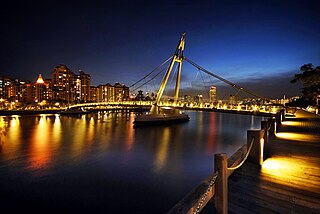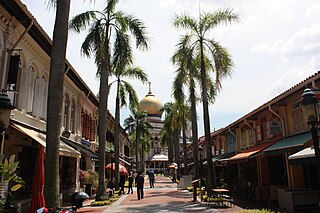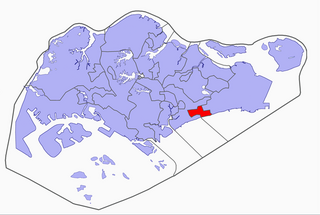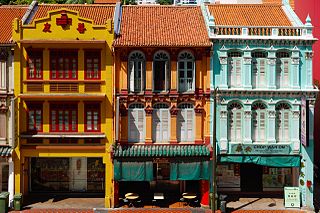
Marine Parade is a planning area and residential estate located in the Central Region of Singapore. Straddling the tip of the southeastern coast of Pulau Ujong, Marine Parade serves as a buffer between the Central and East regions of the city-state. Bordering it are the planning areas of Geylang to the north, Kallang to the northwest, Bedok to the northeast, Marina East to the southwest and the Singapore Straits to the south.

Kallang is a planning area and residential zone located in the Central Region of Singapore.

Bedok is a planning area and residential town located in the geographical region of Tanah Merah along the south-eastern coast of the East Region of Singapore. Bedok is bounded by five other planning areas: Paya Lebar to the north, Hougang to the northwest, Tampines to the northeast and east, Geylang to the west and Marine Parade to the southwest. It also shares a maritime boundary with the Singapore Strait to the south and southeast.

Kampong Glam is a neighbourhood and ethnic enclave in Singapore. It is located north of the Singapore River, in the planning area of Rochor, known as the Malay-Muslim quarter.

Siglap is a neighbourhood located south-west of Bedok in the East Region of Singapore. The area encompasses the Frankel and Opera Estates and their names have sometimes been used interchangeably to refer to the approximate same area. The planning subzone area of Siglap, as defined by the Urban Redevelopment Authority (URA), is confusingly and inaccurately referred to as the small strip of land between Victoria Junior College and Bedok South Avenue 1.
The Bedok Police Division is one of the seven land division of the Singapore Police Force. Bedok Division covers approximately 114 square kilometres of the eastern sector of Singapore. The building became operational on 1 August 1987 when the former Joo Chiat Police Station at East Coast Road was closed down.

Joo Chiat Single Member Constituency was a single member constituency (SMC) located in the eastern region of Singapore. The SMC encompasses the areas of Joo Chiat, Katong, opera estate, Siglap and a portion of Telok Kurau. It had previously existed from 1959 until 1988, when it was merged with neighbouring constituencies to form Bedok Group Representation Constituency. It was reformed just before the 2001 general election after being carved out from East Coast Group Representation Constituency. The seat has been held by the People's Action Party since its reformation that year and was contested again in 2006.

Tanjong Rhu is a subzone within the planning area of Kallang, Singapore, as defined by the Urban Redevelopment Authority (URA). The perimeter of Tanjong Rhu is made up of Nicoll Highway in the north; Mountbatten Road and Fort Road in the east; East Coast Parkway (ECP) in the south; as well as Marina Channel and Kallang Basin in the west. Tanjong Rhu is the largest in terms of physical area among the nine subzones that make up Kallang.

Joo Chiat Road is a road in Katong and a residential conservation area located in the east coast of Singapore. It has won several architectural and heritage awards including the United Nations' UNESCO Asia-Pacific Awards for Cultural Heritage Conservation at 125 Joo Chiat Road. It has overtaken Holland Village in terms of most diverse eateries. Currently, Joo Chiat has become one of the hippiest and coolest towns in Singapore, with both rich and young professionals flocking to its numerous Michelin awarded restaurants. Joo Chiat Road carries a rich historical Peranakan architecture and is infused with rich Peranakan culture, as it has the most historical Peranakan buildings in the Katong district. Joo Chiat was named after a businessman by the name of Chew Joo Chiat after he donated the land to the Municipality of Singapore.
Mountbatten is a neighbourhood located in the planning area of Marine Parade, Singapore.

The South East Community Development Council is one of five Community Development Councils (CDCs) set up across the Republic of Singapore to aid in local administration of governmental policies and schemes. They are funded in part by the government although they are free to engage in fund-raising activities.

Katong Park MRT station is a future underground Mass Rapid Transit station on the Thomson–East Coast line situated at the boundary of the planning areas of Kallang and Marine Parade, Singapore. The station is located underneath the junction of Fort Road, Tanjong Rhu Road and Meyer Road and will serve the Katong Park.

Tanjong Katong MRT station is a future underground Mass Rapid Transit station on the Thomson-East Coast Line in Marine Parade, Singapore.

Marine Parade MRT station is a future underground Mass Rapid Transit station on the Thomson–East Coast line in Marine Parade, Singapore.

Katong laksa is a variant of laksa lemak inspired by the Peranakans who live in the precinct of Katong in Singapore. It has an orangey-yellow colour spicy soup stock, flavoured with coconut milk and dried shrimp, topped with ingredients like cockles, prawns and fishcake. The noodles are normally cut up into smaller pieces so that the entire dish can be eaten with a spoon alone, without chopsticks or a fork.

Sino-Portuguese architecture, also known as Chinese Baroque,Straits/Singapore Eclectic architecture or Peranakan architecture is an Asian hybrid style incorporating elements of both Chinese and Portuguese architectural styles. It is common in urban centers where Chinese settlers lived in southern China and the Peranakans of the Malay Peninsula, with examples found and most prominently conserved and maintained in Singapore.

Katong Park is neighborhood park located in Katong, Singapore at the junction of Meyer Road and Fort Road. Built in the 1930s above the buried remains of Fort Tanjong Katong, it was one of Singapore’s oldest parks with the first public bathing pagar and was highly popular with families during the weekends. After the coastal reclamation works in the 1970s, the park lost its sea frontage and declined greatly in popularity. It now remains as a small community park serving nearby residents.



















